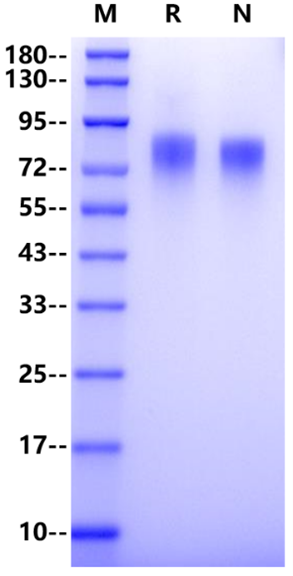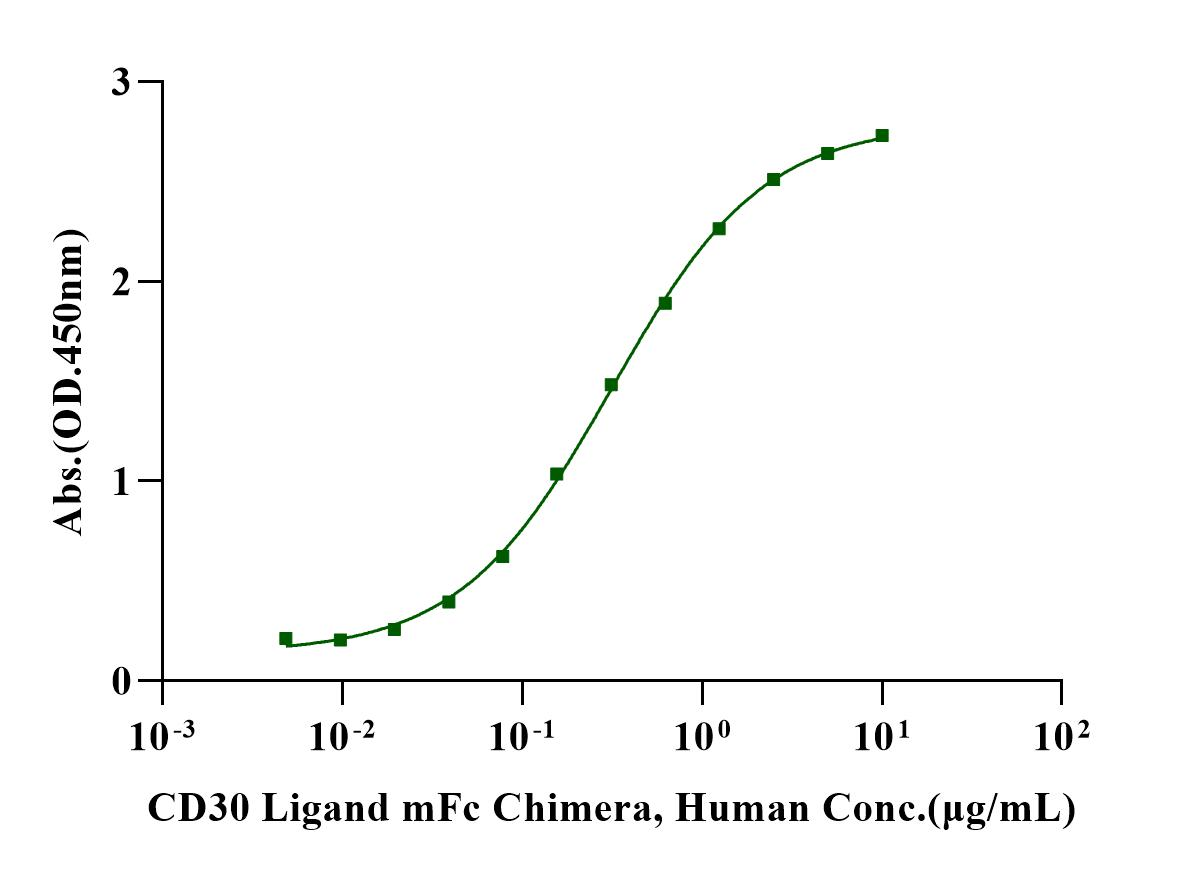Phe19-Lys379, with C-terminal 8* His FPQDRPFEDTCHGNPSHYYDKAVRRCCYRCPMGLFPTQQCPQRPTDCRKQCEPDYYLDEADRCTACVTCSRDDLVEKTPCAWNSSRVCECRPGMFCSTSAVNSCARCFFHSVCPAGMIVKFPGTAQKNTVCEPASPGVSPACASPENCKEPSSGTIPQAKPTPVSPATSSASTMPVRGGTRLAQEAASKLTRAPDSPSSVGRPSSDPGLSPTQPCPEGSGDCRKQCEPDYYLDEAGRCTACVSCSRDDLVEKTPCAWNSSRTCECRPGMICATSATNSCARCVPYPICAAETVTKPQDMAEKDTTFEAPPLGTQPDCNPTPENGEAPASTSPTQSLLVDSQASKTLPIPTSAPVALSSTGKGGGSHHHHHHHH
72-89kDa
Reconstitute at 0.1-1 mg/ml according to the size in ultrapure water after rapid centrifugation.
1、Feghali-Bostwick C A. et al. (2008) Autoantibodies in patients with chronic obstructive pulmonary disease. American Journal of Respiratory and Critical Care Medicine. 177(2): 156-163.
2、Wang G N. et al. (2017) Prognostic significance of CD30 expression in nasal natural killer/T-cell lymphoma. Oncology Letters. 13(3): 1211-1215.
3、Horie R. et al. (1998) A novel domain in the CD30 cytoplasmic tail mediates NFκB activation. International Immunology. 10(2): 203-210.
4、Xu M L. et al. (2020) Practical approaches on CD30 detection and reporting in lymphoma diagnosis. Am J Surg Pathol. 44(2): 1-14.
CD30, a member of the tumor necrosis factor receptor superfamily, also known as Ki-1, is a kind of type I transmembrane glycoprotein. The CD30 protein is composed of 595 amino acids, and the cytosolic and transmembrane region in the protein are composed of 188 amino acids and 24 amino acids, respectively. The extracellular region is the leading peptide of 18 amino acids, followed by 365 amino acids. CD30 is widely expressed in viral-infected lymphocytes and lymphoma cells and activated T cells. Moreover, CD30 is also expressed in alveolar macrophages, epidermal cells, activated NK cells, decidual cells, resting B cells, granulocytes, thymocytes, and medulla cells. The bind of CD30 and CD30L induces the production of cytokine, which promotes cell proliferation, differentiation, cell growth, stagnation, and death. Binding of CD30 with its receptor ligand activates TNF receptor-associated factor (TRAF)2 and TRAF5, initiating signal transduction pathways that can lead either to proliferation or apoptosis. CD30 induced apoptosis may lead to the self-regression seen in lymphomatoid papulosis lesions, whereas proliferation may result in anaplastic large-cell lymphoma (ALCL). CD30 ligation leads to nuclear factor-kappa B (NFκB) and/or mitogen-activated protein kinase (MAPK) pathways, ultimately leading to survival of neoplastic cells. CD30 can serve both as a diagnostic marker for lymphocyte malignancies and as a target for therapy.


Immobilized CD30/TNFRSF8 His Tag, Human (Cat. No. UA010362) at 2μg/mL (100μL/well) can bind Anti-Human CD30 Monoclonal Antibody with EC50 of 4.66-6.44ng/ml.

Immobilized CD30/TNFRSF8 His Tag Protein, Human (Cat. No. UA010362) at 2μg/mL (100μL/well) can bind CD30 Ligand mFc Chimera Protein, Human (Cat. No. UA010378) with EC50 of 0.29-0.34μg/ml.